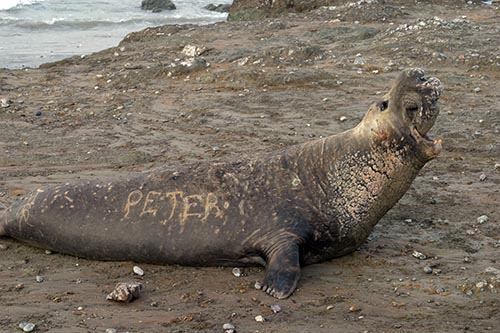Southern elephant seal biology
Southern elephant seals (Pinnipedia: Focidae: Mirounga leonina Linneo 1758) are marine mammals strongly adapted to diving. During their yearly life cycle they spent the most of the time at sea, and they come back to land just for breeding and molting. Breeding males usually come to land well before the haul out of the first female and stay on land for up to three months and more. Mature females stay on land during the breeding season for about one month: during this period they give birth, suckle the pup (mean length of lactation is about 21 days), come into oestrus, copulate and go back to the sea. Apart from a period of about 25 days in which they stay on land for moulting, they spend the rest of their life cycle doing continuous deep dives (up to more than one thousand meters deep) to get enough food to recover from the huge drop in weight and energy reserves they sustain during lactation.
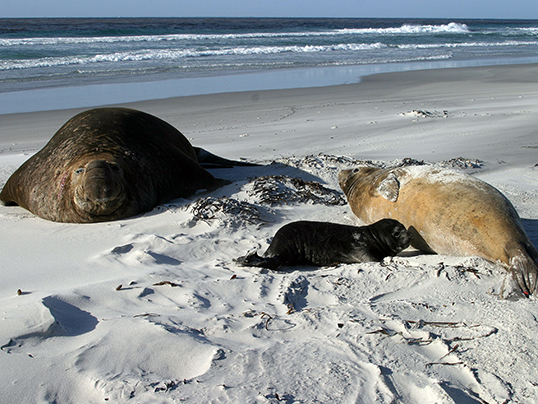
Elephant seal male, female, and pup
During the breeding season females gather in groups of variable size (from 2 to more than 300) traditionally called harems: usually one adult male is in charge of each harem, keeping away the other males and doing the most of the copulations.
Some aspects of southern elephant seals biology are particularly interesting:
- Elephant seals are large (southern elephant seal is the largest species of the Pinnipedia order) and have a large sexual dimorphism in size (the highest in land breeding mammals): due to this large dimorphism males are able to effectively herd females, and this has a strong impact on mating tactics.
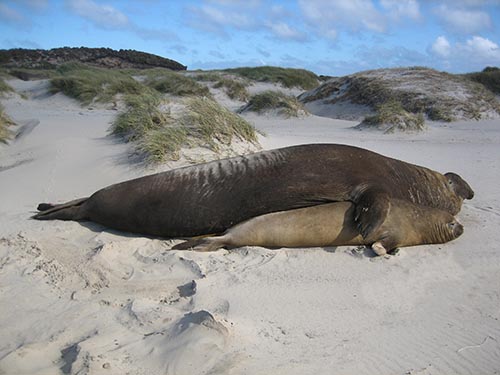
-
Males have also well developed secondary sexual characters (proboscis, enlarged canines, frontal dermal shield), that appears to be the result of past action of sexual selection and adaptation to intense male competition.
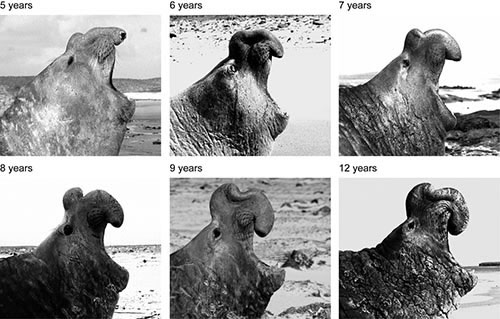
-
They have a mixed life style, with two aquatic phases and two land phases (breeding and molting). The strong adaptation to aquatic life reduces the mobility on land, and this favors grouping and male control of females.

-
They feed during the aquatic phases of the yearly cycle but completely fast during the land ones: the combination of fasting and concentrated breeding effort implies for both males and females a significant energetic stress and a serious weight loss; this high and concentrated breeding effort was probably the drive of a long series of life history adaptations (e.g. delay of breeding in males).
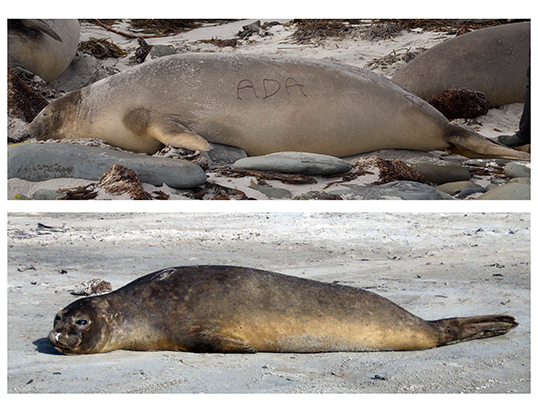
Weight loss: pregnant female just arrived on land (top) and emaciated female at the end of the suckling, just about to go back to sea
-
Growth of males is a two phases process, with a notable growth spur (a huge increase of growth rate) just after puberty. Maturation in males is very long: puberty is reached when they are about five years old, but true maturity is reached only many years later (they usually are not able to get control of an harem until they are nine years old or older).
-
Prebreeding mortality of males is high, hence just a small percentage of each male cohort reach full maturity and start breeding.
-
Breeding is strongly colonial: females concentrate in large groups, of up to many hundreds of individuals. Colonial breeding is the first requirement for the evolution of a polygynous mating system.
-
Reproduction is concentrated in a three months breeding season, and the most of the females breed in a small part of the season (88% of matings in three weeks). A concentrated breeding season is an important requirement for the evolution of a despotic system of mate access.
-
Females have a predictable pattern of presence on land during the breeding season, and this predictability has a significant effect on male mating tactics. On Sea Lion Island females begin to haul out during the second week of September; almost all the females have already gone back to sea by the third week of November. The peak haul out of females is almost constant in each population. A typical female stays on land for 27 days: after a mean of 5 days spent on land she gives birth; then she suckles the pup for a mean of 20 days before coming into estrus; then she copulates for a mean of 2 days with the alpha male of the harem, while carrying on the lactation; at the end she weans the pup (after a mean of 23 days of suckling), leaves the harem and goes back to sea.
-
The mating system of elephant seals is the purest form of harem defence polygyny. Males compete between themselves using both conventional competition and direct fights. The results of dyadic interactions set up an almost linear dominance hierarchy between males, and rank in the hierarchy determines the breeding role. One male, called alpha or harem master, has an almost complete control of each female group (hereafter called harem), and most dominant males are in charge of the largest harems. Beta males (that is to say males in touch with females but subordinates to the alpha) are sometimes present in larger harems, but the most of the males which are not able to get control of an harem are kept outside the female group as peripheral males.
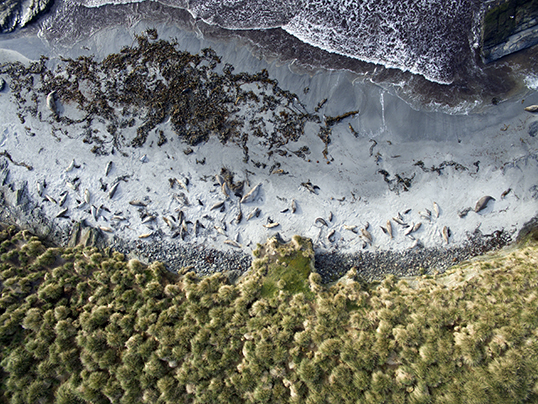
A medium sized harem from the air (south beach of Sea Lion Island)
-
Behavioral interactions between individuals, and males in particular, relay a lot on acoustic communication; acoustic signals are stereotyped and present a large variation between individuals.
